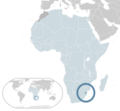Knowledge fuels change
For over a decade, Energypedia has shared free, reliable energy expertise with the world.
We’re now facing a serious funding gap.
Help keep this platform alive — your donation, big or small, truly matters!
Thank you for your support
Difference between revisions of "Swaziland Energy Situation"
***** (***** | *****) m |
***** (***** | *****) |
||
| Line 7: | Line 7: | ||
= Introduction = | = Introduction = | ||
| + | |||
| + | <br/> | ||
= Energy Situation = | = Energy Situation = | ||
| + | |||
| + | <br/> | ||
= Renewable Energy = | = Renewable Energy = | ||
| + | |||
| + | <br/> | ||
= Fossil Fuels = | = Fossil Fuels = | ||
| + | |||
| + | <br/> | ||
= Key Problems of the Energy Sector = | = Key Problems of the Energy Sector = | ||
| + | |||
| + | Power Africa states these issues as the biggest for the country's energy sector<ref name="Power Africa. (2018). Eswatini Factsheet. Retrieved from: https://www.usaid.gov/sites/default/files/documents/1860/eSwatini_-_November_2018_Country_Fact_Sheet.pdf">Power Africa. (2018). Eswatini Factsheet. Retrieved from: https://www.usaid.gov/sites/default/files/documents/1860/eSwatini_-_November_2018_Country_Fact_Sheet.pdf</ref>: | ||
| + | |||
| + | *Lack of clarity in roles for procurement between the Swaziland Energy Regulatory Authority (SERA) and SEC <br/> | ||
| + | *Need for incentives to improve electricity service performance and system to track performance standards<br/> | ||
| + | *Historical reliance on power imports from South Africa <br/> | ||
| + | *Limited ability to provide credit enhancement<br/> | ||
| + | *Utility concerns about large scale integration of intermittent renewables<br/> | ||
| + | |||
| + | <br/> | ||
= Policy Framework, Laws and Regulations = | = Policy Framework, Laws and Regulations = | ||
| + | |||
| + | <br/> | ||
= Institutional Set up in the Energy Sector = | = Institutional Set up in the Energy Sector = | ||
| + | |||
| + | <br/> | ||
= <span style="background-color: rgb(255, 255, 255);">Other Key Actors / Activities of Donors, Implementing Agencies, Civil Society Organisations</span><br/> = | = <span style="background-color: rgb(255, 255, 255);">Other Key Actors / Activities of Donors, Implementing Agencies, Civil Society Organisations</span><br/> = | ||
| + | |||
| + | <br/> | ||
= Further Information = | = Further Information = | ||
| + | |||
| + | *USAID Power Africa: [https://www.usaid.gov/sites/default/files/documents/1860/eSwatini_-_November_2018_Country_Fact_Sheet.pdf Eswatini Factsheet] | ||
| + | |||
| + | <br/> | ||
= References = | = References = | ||
<references /><br/> | <references /><br/> | ||
Revision as of 13:51, 21 January 2020
Capital:
Lobamba
Region:
Coordinates:
26.3167° S, 31.1333° E
Total Area (km²): It includes a country's total area, including areas under inland bodies of water and some coastal waterways.
XML error: Mismatched tag at line 6.
Population: It is based on the de facto definition of population, which counts all residents regardless of legal status or citizenship--except for refugees not permanently settled in the country of asylum, who are generally considered part of the population of their country of origin.
XML error: Mismatched tag at line 6. ()
Rural Population (% of total population): It refers to people living in rural areas as defined by national statistical offices. It is calculated as the difference between total population and urban population.
XML error: Mismatched tag at line 6. ()
GDP (current US$): It is the sum of gross value added by all resident producers in the economy plus any product taxes and minus any subsidies not included in the value of the products. It is calculated without making deductions for depreciation of fabricated assets or for depletion and degradation of natural resources.
XML error: Mismatched tag at line 6.2 ()
GDP Per Capita (current US$): It is gross domestic product divided by midyear population
XML error: Mismatched tag at line 6. ()
Access to Electricity (% of population): It is the percentage of population with access to electricity.
XML error: Mismatched tag at line 6.no data
Energy Imports Net (% of energy use): It is estimated as energy use less production, both measured in oil equivalents. A negative value indicates that the country is a net exporter. Energy use refers to use of primary energy before transformation to other end-use fuels, which is equal to indigenous production plus imports and stock changes, minus exports and fuels supplied to ships and aircraft engaged in international transport.
XML error: Mismatched tag at line 6.no data
Fossil Fuel Energy Consumption (% of total): It comprises coal, oil, petroleum, and natural gas products.
XML error: Mismatched tag at line 6.no data
Introduction
Energy Situation
Renewable Energy
Fossil Fuels
Key Problems of the Energy Sector
Power Africa states these issues as the biggest for the country's energy sector[1]:
- Lack of clarity in roles for procurement between the Swaziland Energy Regulatory Authority (SERA) and SEC
- Need for incentives to improve electricity service performance and system to track performance standards
- Historical reliance on power imports from South Africa
- Limited ability to provide credit enhancement
- Utility concerns about large scale integration of intermittent renewables
Policy Framework, Laws and Regulations
Institutional Set up in the Energy Sector
Other Key Actors / Activities of Donors, Implementing Agencies, Civil Society Organisations
Further Information
- USAID Power Africa: Eswatini Factsheet
References
- ↑ Power Africa. (2018). Eswatini Factsheet. Retrieved from: https://www.usaid.gov/sites/default/files/documents/1860/eSwatini_-_November_2018_Country_Fact_Sheet.pdf





















